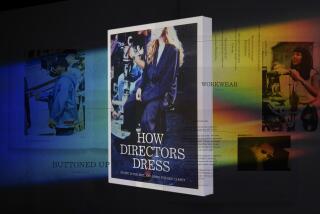DIRECTORS GUILD MARKS GOLDEN ANNIVERSARY
- Share via
Fifty years ago, film directors were like shop foremen. When things went well on the production line, the Big Boss got most of the money and took all of the credit. When things didn’t go so well, the directors were often handed their hats.
Sometimes, they were handed their hats anyway.
Today, they are the elite of the Directors Guild of America, one of the strongest and most prestigious unions in the entertainment industry. When things go well, they get most of the credit and a lot of the money. When things don’t go so well, it is the Big Boss--the head of the studio--who is more likely to be handed his hat.
What happened 50 years ago to cause the turnaround was the formation of the Directors Guild, engineered by 12 directors who were successful enough not to need a union then and savvy enough to know they soon would.
“When the guild began, there wasn’t even a director’s right to have his name on the film,” says current DGA President Gilbert Cates. “We’ve come all the way from that to where we can note, amusingly, that our contract has a requirement for an office and a door and a chair and a phone and--most elusive of all things in California--a parking space.”
What’s more, says Cates, the office has to be near a restroom.
All this is clearly cause for celebration, and the DGA--officially launching its Golden Jubilee with a Jan. 18 birthday party at guild headquarters at the east end of the Sunset Strip--will be at it for the next nine months.
The jubilee actually began Friday when 87-year-old director Rouben Mamoulian, the surviving member of the dozen DGA founders, appeared with two of his best films (the 1932 “Love Me Tonight” and the 1941 “Blood and Sand”) at the opening of a two-month DGA retrospective at the County Museum of Art.
Mamoulian is one of more than a dozen well-known directors who will be on the road for the DGA during 1986, appearing at retrospectives in eight major cities in an attempt to raise public awareness about the role of the director and his associates in the creation of films.
The jubilee, which is costing the guild’s 7,800 members $500,000, won’t end until September when the DGA hopes to host a World Congress of Directors at the United Nations in New York. In between, there will be two DGA-commissioned books (one an archival history, the other a coffee table book), two films (including a 6-minute short that will be attached to major studio releases during the year and shown in movie theaters), plus TV and radio programs intended to promote the activities of members in those branches of the guild.
The DGA was originally a film-directors-only union. Today, its membership includes directors of TV movies and series, sports and news broadcasts, and even directors working in radio. There are assistant and associate directors, unit production managers and stage managers.
The broader membership roll may give the DGA clout, but it also blurs its definition. The career track that most stage and production managers are on is that of the producer.
Anyway, the real heat of the Golden Jubilee celebration will be given off by its feature film directors, a roster that has boasted Hollywood’s brightest and most powerful creative forces.
With such members as Mamoulian, Martin Ritt, Joseph Mankiewicz and Arthur Penn making the retrospective rounds, American movie lovers are going to be reminded that film--the best of it anyway--is a director’s medium.
The industry has changed dramatically since King Vidor invited a few of his colleagues to his home in early January, 1936, to discuss forming the directors union.
The old studio system, in which directors were mere hired hands, collapsed under antitrust pressures. Television came along and introduced the dramatic pause called the commercial. A senator named McCarthy, calling the DGA a haven for Communists, turned members against each other.
The fact that Charlie Chaplin was denied membership for refusing to sign a red-baiting loyalty oath is a smudge the DGA will never be able to erase.
Today, the major concerns of the guild are more technological than political. Once there were movies and theaters. Now there are movies and theaters and network television and syndication and videocassettes and laser discs and satellite dishes.
The aftermarket--the various electronic boneyards to which feature films are assigned after their theatrical runs--are often more lucrative than the theaters, and the result seems to be a flattening of quality. It’s getting harder and harder to note the differences between features and movies made for TV.
No one seems eager to return to the days when tyrants like Louis B. Mayer and Jack Warner ran the studios, but there were advantages.
“Some of them were rough cobs,” says director Robert Wise (“Sound of Music”), chairman of the Golden Jubilee committee, “but my golly, they were film people and they loved film.”
As the DGA parties its way toward its second half-century, there are public relations problems involving safety, the low percentage of women (15%) and minority (4%) members, and the dreadful quality of most films and TV shows.
The guild also has its continuing aggravations. The arbitrary editing done by local TV stations to shoehorn Size 10 movies into Size 6 time slots. Sloppy maintenance of projection and sound equipment in theaters. The difficult task of tracking product for collection of residuals.
But Cates and Wise find nothing ahead of the year’s celebration but more to celebrate.
The guild will break ground this summer on a six-story complex next to its 30-year-old Sunset Boulevard headquarters. Membership is expected to top 8,000 by the end of the year. And although no one can predict how the video boom will shake out, directors will be in business.
“Whether it’s shown on cassette, laser disc, TV or in theaters,” Cates says, “people will have to make the product.”
RADICAL: Call the Teen Hot Line! The adults are taking over America’s movie theaters.
In the last three weeks, Sydney Pollack’s “Out of Africa” and Steven Spielberg’s “The Color Purple”--one based on a novel about a Danish aristocrat in Africa, the other on a novel about the spiritual growth of a poor black woman in the South--have grossed more than $40 million between them.
Bud Yorkin’s domestic drama “Twice in a Lifetime” also had a good weekend in limited national release. And in exclusive runs, Martin Ritt’s “Murphy’s Romance,” Terry Gilliam’s “Brazil,” Hugh Hudson’s “Revolution,” Akira Kurosawa’s “Ran,” Robert Altman’s “Fool for Love,” Andrei Konchalovsky’s “Runaway Train” and Peter Masterson’s “The Trip to Bountiful” all did solid business.
For the sixth straight week, “Rocky IV” led the weekend box office chart, but its receipts were down 34% from a week earlier, and it is playing in more than twice as many theaters (2,254 to 928) as second-place “Out of Africa.”
Measured by the lines outside theaters, “The Color Purple” is the nation’s hottest movie. “Purple” averaged $16,267 in 209 theaters.
The weekend’s top 10: “Rocky IV” ($7.1 million). “Out of Africa” ($6.4). “Jewel of the Nile” ($5.9 million). “Spies Like Us” ($5 million). “101 Dalmatians” ($4 million). “White Nights” ($3.8 million). “The Color Purple” ($3.4 million). “Head Office” ($1.9 million). “A Chorus Line” ($1.9 million). “Young Sherlock Holmes” ($1.9 million).
More to Read
The biggest entertainment stories
Get our big stories about Hollywood, film, television, music, arts, culture and more right in your inbox as soon as they publish.
You may occasionally receive promotional content from the Los Angeles Times.










